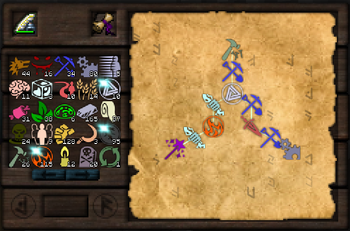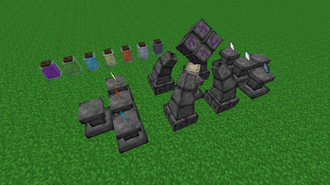(→Use) |
|||
| Line 8: | Line 8: | ||
==Instability== |
==Instability== |
||
In the Thaumonomicon, an instability difficulty is listed at the bottom of the infusion recipe, from negligible to dangerous. Instability can cause bad things to happen, such as items being knocked off of pedestals, or as far as releasing flux into the environment. For this reason, it's important to reduce instability by all means. Certain magical paraphernalia reduces the instability of the altar; however, the placement is important. Pedestals, ingredients, and stabilizers must be paired, across the altar, with radial symmetry. (Same Y coordinate, but with opposite distances in X and Z.) Unmatched items will increase instability. Stabilizing items include mob or player heads/skulls, tallow candles, and crystal clusters. Stabilizers must be within a range of five blocks above the matrix, ten below, and 12 blocks in each horizontal direction. This allows plenty of space to place stabilizers, often in a "candle room" below the altar. |
In the Thaumonomicon, an instability difficulty is listed at the bottom of the infusion recipe, from negligible to dangerous. Instability can cause bad things to happen, such as items being knocked off of pedestals, or as far as releasing flux into the environment. For this reason, it's important to reduce instability by all means. Certain magical paraphernalia reduces the instability of the altar; however, the placement is important. Pedestals, ingredients, and stabilizers must be paired, across the altar, with radial symmetry. (Same Y coordinate, but with opposite distances in X and Z.) Unmatched items will increase instability. Stabilizing items include mob or player heads/skulls, tallow candles, and crystal clusters. Stabilizers must be within a range of five blocks above the matrix, ten below, and 12 blocks in each horizontal direction. This allows plenty of space to place stabilizers, often in a "candle room" below the altar. |
||
| + | |||
| + | Note: While instability can be countered with candles and skulls and such, more stabilizers will result in the runic matrix moving more during the infusion. This is completely normal and will not cause any further instability or problems, it's purely graphical and will not influence your altar. |
||
Warning: The active instability can increase over the course of an infusion, but never decrease. If an infusion is getting out of hand, or just mysteriously stalled, it can be aborted by removing the central (target) item from its pedestal. This will produce one final burst of instability effects. Note that while instability can knock off or destroy items on the outer pedestals, it will never affect the target item. |
Warning: The active instability can increase over the course of an infusion, but never decrease. If an infusion is getting out of hand, or just mysteriously stalled, it can be aborted by removing the central (target) item from its pedestal. This will produce one final burst of instability effects. Note that while instability can knock off or destroy items on the outer pedestals, it will never affect the target item. |
||
Latest revision as of 12:51, 4 January 2019
Overview[]

Infusion Research in TC 4.2.3.5
Infusion is the process of binding items and essentia to a central item to change its properties. The process requires an Infusion altar, surrounded by two to twelve pedestals, which will hold the items to be infused. The items do not need to be placed in a particular order around the altar, however it is imperative to keep as much symmetry as possible.
This page gives a casual overview; for more detailed information, see Infusion mechanics.
Instability[]
In the Thaumonomicon, an instability difficulty is listed at the bottom of the infusion recipe, from negligible to dangerous. Instability can cause bad things to happen, such as items being knocked off of pedestals, or as far as releasing flux into the environment. For this reason, it's important to reduce instability by all means. Certain magical paraphernalia reduces the instability of the altar; however, the placement is important. Pedestals, ingredients, and stabilizers must be paired, across the altar, with radial symmetry. (Same Y coordinate, but with opposite distances in X and Z.) Unmatched items will increase instability. Stabilizing items include mob or player heads/skulls, tallow candles, and crystal clusters. Stabilizers must be within a range of five blocks above the matrix, ten below, and 12 blocks in each horizontal direction. This allows plenty of space to place stabilizers, often in a "candle room" below the altar.
Note: While instability can be countered with candles and skulls and such, more stabilizers will result in the runic matrix moving more during the infusion. This is completely normal and will not cause any further instability or problems, it's purely graphical and will not influence your altar.
Warning: The active instability can increase over the course of an infusion, but never decrease. If an infusion is getting out of hand, or just mysteriously stalled, it can be aborted by removing the central (target) item from its pedestal. This will produce one final burst of instability effects. Note that while instability can knock off or destroy items on the outer pedestals, it will never affect the target item.
Use[]

The picture on the right shows an infusion setup for creating a silverwood wand core. The first step is placing the target (a silverwood log) in the center of the altar, then placing the other ingredients on pedestals surrounding, maintaining symmetry as best as possible. Note the empty pedestal: Even with an odd number of ingredients, it's better to balance the pedestals.
It is also necessary to supply the essentia needed for the recipe. This can come from any sort of essentia container, and can also be relayed by way of essentia mirrors: Jars (warded or void), reservoirs, or mirrors need to be placed within 12 blocks of the Matrix, but these do not have to be symmetrical. For the recipe shown 9 of each primal aspect and 9 Praecantatio are required. Providing extra is safer, because instability or other factors can add to the "official" cost. Then you have to right-click on the runic matrix with your wand and it will start the infusion. During the process the essentia will be automatically drawn from the jars etc. into the item. After the essentia is infused, the center item absorbs the surrounding items one by one, and if this succeeds, the center item will turn into the infused item. Again, the infusion can be aborted at any time by removing the center item from its pedestal.
Thaumonomicon entry[]
"Arcane crafting and alchemy can go only so far. Something better is needed to create truly powerful mystical objects.
Infusion crafting is the process of infusing a single object with magical energy and the properties of other objects. For example, you could infuse a stone with vis and a feather and it would result in very light stone.
As is usual with Thaumaturgy, things are not quite that simple. To even get started with infusion crafting there are several things you need: a Runic Matrix, Arcane Pedestal, and a ready supply of magic in form of Essentia."
Infusion Enchanting[]
Later research will allow you to use the infusion altar for another use, enchanting. Using salis mundus, the appropriate item, and some essentia, you can apply any enchantment to an item. The rules for enchanting still apply; for example, you cannot apply both fire protection and blast protection to a piece of armor using infusion enchanting.
